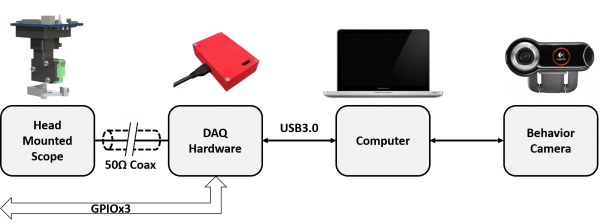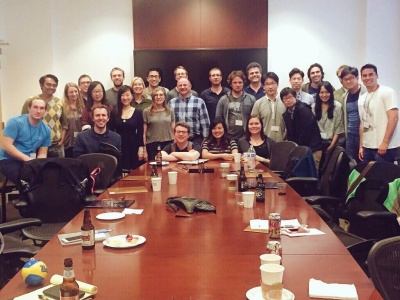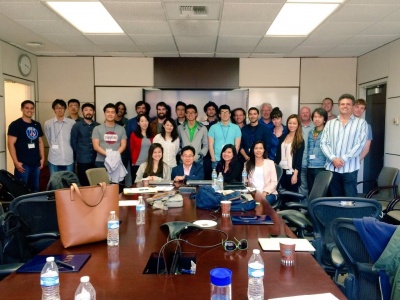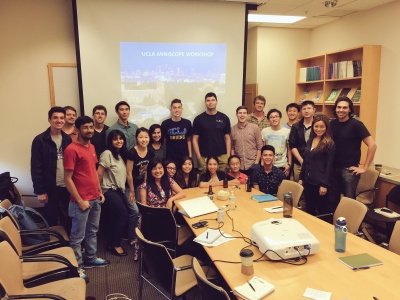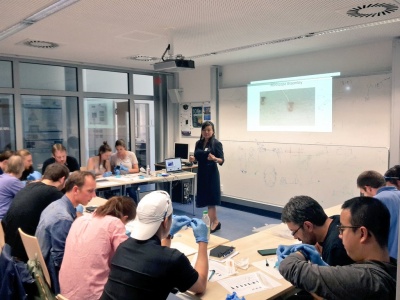Difference between revisions of "Main Page"
(→Update Log) |
Valadares61 (talk | contribs) (@pump_upp - best crypto pumps on telegram !) |
||
| (34 intermediate revisions by one other user not shown) | |||
| Line 1: | Line 1: | ||
| − | [[File: | + | |
| + | |||
| + | '''Quick Announcement:''' We have multiple Postdoc/Engineering/Researcher positions open within the Miniscope project! Looking for exceptional, creative people interested in instrumentation/tool/software development and who can effectively communicate in both the fields of engineering and neuroscience. A job listing for one of the open positions can be found [https://www.nature.com/naturejobs/science/jobs/654273-postdoctoral-fellow-engineer here]. If interested please contact Daniel Aharoni, DBAharoni_at_gmail.com. | ||
| + | |||
| + | <br clear=all> | ||
| + | |||
| + | [[File:miniscopev4_render.png|thumb|300px]] | ||
| + | |||
'''Welcome to Miniscope.org Wiki! Follow the project on Twitter: [https://twitter.com/MiniscopeTeam @MiniscopeTeam].''' | '''Welcome to Miniscope.org Wiki! Follow the project on Twitter: [https://twitter.com/MiniscopeTeam @MiniscopeTeam].''' | ||
| − | + | We are happy to announce the release of our next generation, open-source Miniscope platform, [[Miniscope V4]]. This new system is a substantial leap forward over previous designs and will serve as the base Miniscope platform for years to come. An overview of new features can be found below: | |
| + | |||
| + | * >1mm diameter field of view | ||
| + | * ~1mm working distance | ||
| + | * +/-200um electronic focal adjustment | ||
| + | * All achromatic optics | ||
| + | * 2.6 grams | ||
| + | * 22mm tall | ||
| + | * Absolute head orientation sensor | ||
| + | * Requires ~1/5th the excitation power of previous systems | ||
| + | * No more soldering! | ||
| + | * Still uses only a single coaxial cable (down to 0.3mm in diameter) for power, communication, and data. | ||
| + | * New DAQ software | ||
| + | |||
| + | This wiki site provides a centralized location for sharing design files, source code, and other relevant information so that a community of users can share ideas and developments related to this important imaging technique. Our goal is to help disseminate this technology to the larger neuroscience community and build a foundation of users that will continue advancing this technology and contribute back to the project. While the Miniscope system described here is not an off-the-shelf commercial solution, we have focused on making it as easy as possible for the average neuroscience lab to build and modify, requiring no soldering and simple hands-on assembly. The Miniscope project and Miniscope.org are on going projects and will be routinely updated over the coming months and years. | ||
== Current Status of Project == | == Current Status of Project == | ||
| − | The Miniscope project is now in its | + | The Miniscope project is now in its 6th year of development at UCLA and in its third major revision. Miniscope developers have used Miniscopes to understand [http://www.nature.com/nature/journal/v534/n7605/full/nature17955.html how the brain links memories across time in Nature, 2016] and how [https://www.nature.com/articles/s41593-019-0559-0 spatial coding breaks down in epilepsy in Nature Neuroscience, 2019]. The work and files available on this site are the most up-to-date public version of our system and will be updated frequently with improvements and new system features. We encourage Miniscope users to contribute to this development process! This wiki is designed for this very purpose. |
Initial access to the miniscope.org wiki was enabled mid January, 2016. | Initial access to the miniscope.org wiki was enabled mid January, 2016. | ||
| Line 11: | Line 32: | ||
'''Important:''' Using this system we have successfully imaged Hippocampal CA1, Subiculum, Dorsal Striatum, Parietal Cortex, Prefrontal Cortex, and Visual Cortex using 0.5mm, 1mm, 1.8mm, and 2mm diameter GRIN lenses from either Grintech or GoFoton. (More information on GRIN lenses can be found [[GRIN Lens Information|here]]). | '''Important:''' Using this system we have successfully imaged Hippocampal CA1, Subiculum, Dorsal Striatum, Parietal Cortex, Prefrontal Cortex, and Visual Cortex using 0.5mm, 1mm, 1.8mm, and 2mm diameter GRIN lenses from either Grintech or GoFoton. (More information on GRIN lenses can be found [[GRIN Lens Information|here]]). | ||
| − | {{#ev:youtube|https://youtu.be/ | + | {{#ev:youtube|https://youtu.be/xUf7HHiazEI|640|center}} |
| − | |||
| − | |||
<br clear=all> | <br clear=all> | ||
| − | == Links to information on | + | == Links to information on Miniscope subsystems == |
[[File:Overview_System.png|thumb|600px]] | [[File:Overview_System.png|thumb|600px]] | ||
| − | |||
| − | :[[ | + | Information on the newest generation of the UCLA Miniscope platform can be found here: |
| + | :[[Miniscope V4]] | ||
| + | |||
| + | Our currently release Wire-Free Miniscope (based on the Version 3 Miniscope platform can be found here: | ||
| + | :[[Information on the Version 3 Wire-free Miniscope platform]] | ||
| + | Information on the past Miniscope platforms(s) can be found here: | ||
| + | :[[Information on the (previous Version 3) Miniscope platform]] | ||
| − | : | + | Additional information relating to Miniscope imaging can be found below: |
:[[Surgery Protocol]] | :[[Surgery Protocol]] | ||
| − | |||
| − | |||
:[[Analysis Package]] | :[[Analysis Package]] | ||
| Line 35: | Line 57: | ||
<br clear=all> | <br clear=all> | ||
| − | + | https://t.me/pump_upp - best crypto pumps on telegram | |
| − | + | Make 1000% and more within 1 day, join channel @pump_upp ! | |
| − | |||
== Guides and Tutorials== | == Guides and Tutorials== | ||
A key feature of this effort is to design miniscope systems that are easy to build and use. The guides below will walk you through component procurement, scope assembly, and software installation. | A key feature of this effort is to design miniscope systems that are easy to build and use. The guides below will walk you through component procurement, scope assembly, and software installation. | ||
| − | + | Guides and tutorials for the current, Version 4, Miniscope platform: | |
| − | + | :[[Miniscope V4]] | |
| − | + | ||
| − | + | Past guides and tutorials can be found here: | |
| − | + | :[[Information on the (previous Version 3) Miniscope platform]] | |
| − | |||
| − | |||
| − | |||
| − | |||
== Workshop Resource == | == Workshop Resource == | ||
| Line 75: | Line 92: | ||
== Update Log == | == Update Log == | ||
| + | ;01/31/2020 | ||
| + | :Added Miniscope V4 information, tutorials, design files, and source code | ||
| + | ;05/21/2019 | ||
| + | :Added [[Wire-free Miniscope]] tutorials, design files, and source code | ||
| + | ;11/29/2018 | ||
| + | :Updated GoFoton GRIN lens information | ||
| + | ;06/21/2018 | ||
| + | :Added link and information to MIN1PIPE analysis package on the [[Analysis Package]] page and [[Other_Open_Source_Projects]] page | ||
| + | ;05/24/2018 | ||
| + | :Updated the [[Analysis Package]] page and [[Other_Open_Source_Projects]] page | ||
| + | ;04/14/2018 | ||
| + | :Updated the Master Parts List for more up-to-date information and comments | ||
| + | ;01/27/2018 | ||
| + | :Added [[Miniscope Gripper]] by Bastijn van den Boom at NIN | ||
;11/6/2017 | ;11/6/2017 | ||
:Added [[Miniscope Baseplate and Protective Cone for Rats]] by Bastijn van den Boom at NIN | :Added [[Miniscope Baseplate and Protective Cone for Rats]] by Bastijn van den Boom at NIN | ||
Latest revision as of 12:08, 5 February 2023
Quick Announcement: We have multiple Postdoc/Engineering/Researcher positions open within the Miniscope project! Looking for exceptional, creative people interested in instrumentation/tool/software development and who can effectively communicate in both the fields of engineering and neuroscience. A job listing for one of the open positions can be found here. If interested please contact Daniel Aharoni, DBAharoni_at_gmail.com.
Welcome to Miniscope.org Wiki! Follow the project on Twitter: @MiniscopeTeam.
We are happy to announce the release of our next generation, open-source Miniscope platform, Miniscope V4. This new system is a substantial leap forward over previous designs and will serve as the base Miniscope platform for years to come. An overview of new features can be found below:
- >1mm diameter field of view
- ~1mm working distance
- +/-200um electronic focal adjustment
- All achromatic optics
- 2.6 grams
- 22mm tall
- Absolute head orientation sensor
- Requires ~1/5th the excitation power of previous systems
- No more soldering!
- Still uses only a single coaxial cable (down to 0.3mm in diameter) for power, communication, and data.
- New DAQ software
This wiki site provides a centralized location for sharing design files, source code, and other relevant information so that a community of users can share ideas and developments related to this important imaging technique. Our goal is to help disseminate this technology to the larger neuroscience community and build a foundation of users that will continue advancing this technology and contribute back to the project. While the Miniscope system described here is not an off-the-shelf commercial solution, we have focused on making it as easy as possible for the average neuroscience lab to build and modify, requiring no soldering and simple hands-on assembly. The Miniscope project and Miniscope.org are on going projects and will be routinely updated over the coming months and years.
Contents
Current Status of Project
The Miniscope project is now in its 6th year of development at UCLA and in its third major revision. Miniscope developers have used Miniscopes to understand how the brain links memories across time in Nature, 2016 and how spatial coding breaks down in epilepsy in Nature Neuroscience, 2019. The work and files available on this site are the most up-to-date public version of our system and will be updated frequently with improvements and new system features. We encourage Miniscope users to contribute to this development process! This wiki is designed for this very purpose.
Initial access to the miniscope.org wiki was enabled mid January, 2016.
Important: Using this system we have successfully imaged Hippocampal CA1, Subiculum, Dorsal Striatum, Parietal Cortex, Prefrontal Cortex, and Visual Cortex using 0.5mm, 1mm, 1.8mm, and 2mm diameter GRIN lenses from either Grintech or GoFoton. (More information on GRIN lenses can be found here).
Links to information on Miniscope subsystems
Information on the newest generation of the UCLA Miniscope platform can be found here:
Our currently release Wire-Free Miniscope (based on the Version 3 Miniscope platform can be found here:
Information on the past Miniscope platforms(s) can be found here:
Additional information relating to Miniscope imaging can be found below:
https://t.me/pump_upp - best crypto pumps on telegram Make 1000% and more within 1 day, join channel @pump_upp !
Guides and Tutorials
A key feature of this effort is to design miniscope systems that are easy to build and use. The guides below will walk you through component procurement, scope assembly, and software installation.
Guides and tutorials for the current, Version 4, Miniscope platform:
Past guides and tutorials can be found here:
Workshop Resource
We will be holding a pre-SfN workshop November 9th, 2017. For more information visit our MCCS/ICLM Workshop Page.
The Golshani, Silva, and Khakh labs will be hosting free, two-day long Miniscope workshops here at UCLA. We are currently planning at least 3 workshops for 2018. Please enter your information here to request a spot in upcoming workshops.
If you cannot attend one of our workshops, presentations, data files, and workshop videos can be found on our Online Workshop page.
Miniscope Community Member Pages
Update Log
- 01/31/2020
- Added Miniscope V4 information, tutorials, design files, and source code
- 05/21/2019
- Added Wire-free Miniscope tutorials, design files, and source code
- 11/29/2018
- Updated GoFoton GRIN lens information
- 06/21/2018
- Added link and information to MIN1PIPE analysis package on the Analysis Package page and Other_Open_Source_Projects page
- 05/24/2018
- Updated the Analysis Package page and Other_Open_Source_Projects page
- 04/14/2018
- Updated the Master Parts List for more up-to-date information and comments
- 01/27/2018
- Added Miniscope Gripper by Bastijn van den Boom at NIN
- 11/6/2017
- Added Miniscope Baseplate and Protective Cone for Rats by Bastijn van den Boom at NIN
- 5/2/2017
- Updated 'Additional Open Source Resources' to include CNMF-E from the Paninski Lab and an open source miniature microscope from the Gardner Lab.
- 2/01/2017
- Added additional assembly and surgery tutorial videos.
- 11/29/2016
- Added a link on the front page to request a spot in upcoming Miniscope workshops.
- 10/28/2016
- Added version 3.2 of the DAQ PCB to the GitHub repository.
- 07/28/2016
- Added a new group PCB order signup sheet here.
- 07/21/2016
- Fixed bug that would crash the Miniscope DAQ software when using the 'Trigger Ext' option. This option is now fully functional and allows one to remotely trigger the Miniscope to record using a LVTTL or TTL high signal.
- 04/20/2016
- Added Initial Testing of Assembled Miniscopes which outlines the process of testing new Miniscope systems.
- 04/16/2016
- Added Imaging With Thin GRIN Lenses describing how to use Miniscopes to image with GRIN lenses 1mm diameter and thinner.
- 04/12/2016
- Added a new group PCB order signup sheet here.
- 04/13/2016
- Updated the GitHub repository to include the newer version of the CMOS Imaging Sensor PCB (v3.2).
- 03/25/2016
- Updated the Surgery and Baseplating Presentation link.
- Updated the Recommended Computer Specs page... Apparently a MacBook Pro running Windows 8 doesn't always agree with the Miniscope system.
- 03/18/2016
- Added the DAQ housing design files to our GitHub repository.
- 03/16/2016
- Added a Member Pages page for sharing miniscope.org member created pages.
- 02/24/2016
- Added a set of example Miniscope data to the Workshop Resources page.
- 02/17/2016
- Added a new way to connectorize the coaxial cable. This update includes a new PCB design on the GitHub repository as well as an assembly video on the System Assembly page.
- 02/10/2016
- Started adding videos to the Workshop Resource and System Assembly page
- 02/05/2016
- Updated the DAQ Software and Firmware to support FPS adjustment. The source code and compiled files can be found on our GitHub repository.
- 02/03/2016
- Updated Surgery Tools on Miniscope Master Parts List
- 01/28/2016
- Added PCB price quotes to reference when ordering PCB fabrication and assembly through Sierra Circuits. They can be found on the Part Procurement page.
- 01/27/2016
- IMPORTANT: Updated CMOS Imaging Sensor PCB Fabrication file to newest version
- 01/20/2016
- Updated Surgery Tools on Miniscope Master Parts List
- Added GRIN lens specifications on GRIN Lens Information page
- Updated the PCB Assembly documents on Github will a more detailed description of SMD LED orientation
- Slight modification to the Baseplate 3D model on Github
- 01/14/2016
- Comments added to segmentation functions
- Added through-hole components for DAQ PCB on Master Parts List
- Added additional soldering tools on Master Parts List
- 01/13/2016
- Added basic surgery outline
- Added a picture guide for scope and Baseplate assembly
- 01/12/2016
- Finalizing of Miniscope Master Parts List
- 01/10/2016
- Upload of current version of all files and documents to Github
- 01/09/2016
- Added guide to programming firmware to DAQ PCB

